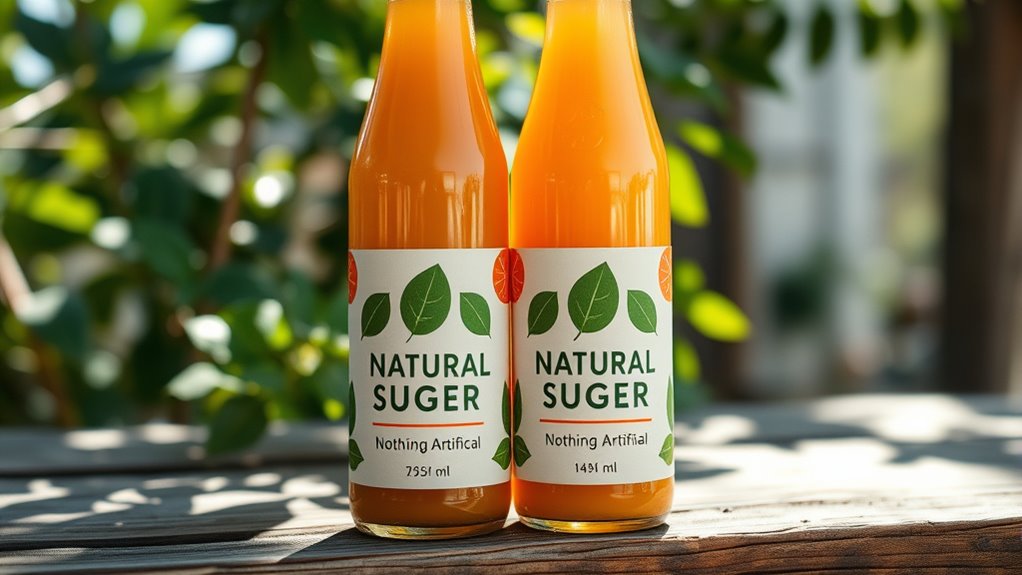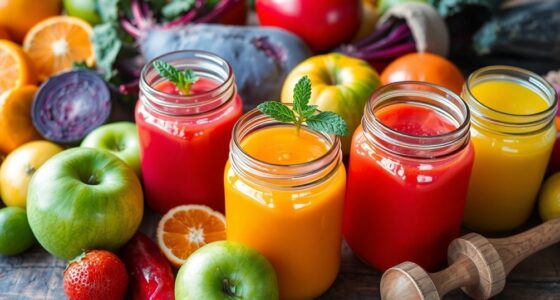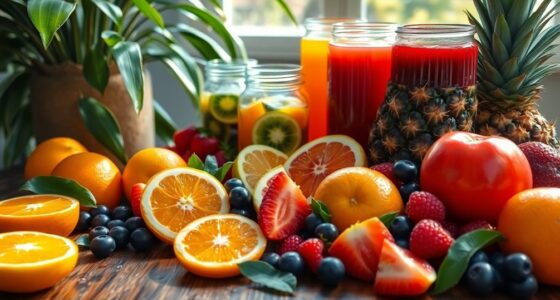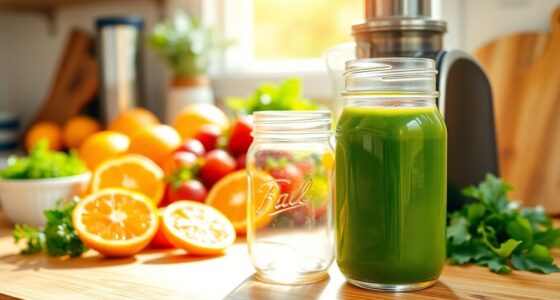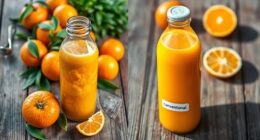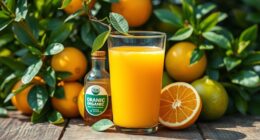When you see labels claiming “No Added Sugar” and “Nothing Artificial,” they’re designed to catch your eye with visuals like fresh fruit images, bright colors, and simple fonts that suggest naturalness and purity. These cues, combined with clear wording, help you trust that the juice is minimally processed and free from synthetic ingredients. Understanding how these labels work can guide your choices, and there’s more to uncover about how packaging influences your perception of natural products.
Key Takeaways
- Labels stating “No Added Sugar” often mean sweetness is from natural fruit sugars or extracts, not synthetic sweeteners.
- “Nothing Artificial” claims indicate absence of synthetic ingredients, supported by transparent ingredient lists and regulatory standards.
- Visual cues like ripe fruit images and bright colors reinforce the impression of freshness and natural content.
- Packaging design, including clear labeling, helps consumers trust the product’s authenticity and minimal processing.
- Regulatory oversight ensures that claims like “No Added Sugar” and “Nothing Artificial” are truthful and support informed purchasing decisions.

When shopping for juice, the label can tell you more than just the flavor—it reveals whether the product is truly natural. Labels that highlight “No Added Sugar” or “Nothing Artificial” are intended to give you confidence in your choice, but they can also be a little misleading if you don’t pay attention to the details. One way brands communicate authenticity is through their packaging design, which often incorporates visual cues like fresh fruit images or clean, simple fonts to suggest purity. These design elements, combined with claims like “No Added Sugar,” aim to reassure you that what’s inside is free from artificial ingredients and unnecessary additives.
Packaging design with fresh fruit images and simple fonts suggests natural, authentic juice options.
A key aspect of understanding these labels lies in recognizing the role of fruit extracts. Many natural juices rely on fruit extracts to deliver flavor without the need for added sugars or artificial flavorings. When a label states “No Added Sugar,” it means the sweetness comes solely from the fruit itself or its natural sugars, which are preserved through processes like pasteurization or cold-pressing. These extracts are carefully selected to maintain the authentic taste of the fruit, providing a genuine flavor profile that appeals to health-conscious consumers. If you examine the ingredients list closely, you’ll often see that the juice’s flavor is derived from concentrated fruit extracts rather than synthetic additives.
Packaging design plays a vital role in how these claims are perceived. Bright colors, imagery of ripe fruits, and minimalist layouts shape your impression of a product’s purity. Brands that emphasize “Nothing Artificial” usually opt for transparent bottles or clear labeling to highlight the absence of artificial dyes and preservatives. Some labels even include icons or seals that indicate the product has been tested for artificial ingredients, further reinforcing the message. When you see these design cues, it’s easier to trust that the juice is minimally processed and aligns with your desire for natural options. Additionally, understanding regulatory standards and how they impact labeling claims can help ensure you’re making informed choices about what you’re drinking.
Frequently Asked Questions
How Is ‘No Added Sugar’ Different From Naturally Occurring Sugars?
You’ll notice that ‘no added sugar’ means the juice doesn’t have extra sugar added during processing, but it still contains naturally occurring sugars from fruits or vegetables. These naturally occurring sugars provide natural sweetness and contribute to the overall sugar content. So, while the label indicates no added sugars, the juice can still be sweet because of these natural sugars, making it a healthier choice with fewer refined sugars.
Can ‘Nothing Artificial’ Mean the Juice Has Preservatives?
When a juice label says ‘nothing artificial,’ it doesn’t necessarily mean there are no preservatives. It often indicates no artificial flavors or colors, but preservatives can still be present as artificial additives to extend shelf life. Always check the ingredient list for specific preservative names. Just because a label claims ‘nothing artificial’ doesn’t guarantee the absence of preservative presence; it depends on the product’s formulation.
Are Organic Ingredients Required for These Labels?
You can’t assume organic ingredients are required for these labels. While organic standards and certification processes guarantee higher quality, ‘No Added Sugar’ and ‘Nothing Artificial’ don’t necessarily mean organic. Sometimes, manufacturers use natural ingredients that aren’t certified organic. It’s worth checking the label for specific certifications like USDA Organic. Remember, just because it’s labeled natural doesn’t mean it meets all organic standards—always read the fine print.
Do These Labels Guarantee the Juice Is Completely Healthy?
These labels don’t guarantee the juice is completely healthy. While they indicate no added sugar and no artificial ingredients, the sugar content from natural sources like fruit remains. You should check ingredient transparency to see what’s truly in your juice. Even with these labels, it’s smart to read nutrition labels carefully and enjoy juice in moderation, focusing on overall diet quality for better health.
How Can I Verify the Authenticity of These Claims?
Imagine holding a juice bottle, and sunlight filters through, revealing its clarity. To validate claims, check the ingredient sourcing on the label—look for transparency about where ingredients come from. Seek third-party certifications like USDA Organic or Non-GMO Project Verified, which add credibility. These marks and detailed sourcing info help guarantee the labels are genuine, guiding you toward healthier choices without relying solely on marketing claims.
Conclusion
When you see labels claiming “no added sugar” and “nothing artificial,” remember to read between the lines. These labels can be a good starting point, but always check the ingredients to be sure. Don’t let false promises fool you; a little due diligence goes a long way. Trust your instincts and keep an eye out for hidden additives. After all, it’s better to be safe than sorry—sometimes, appearances can be deceiving.

